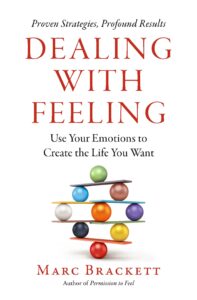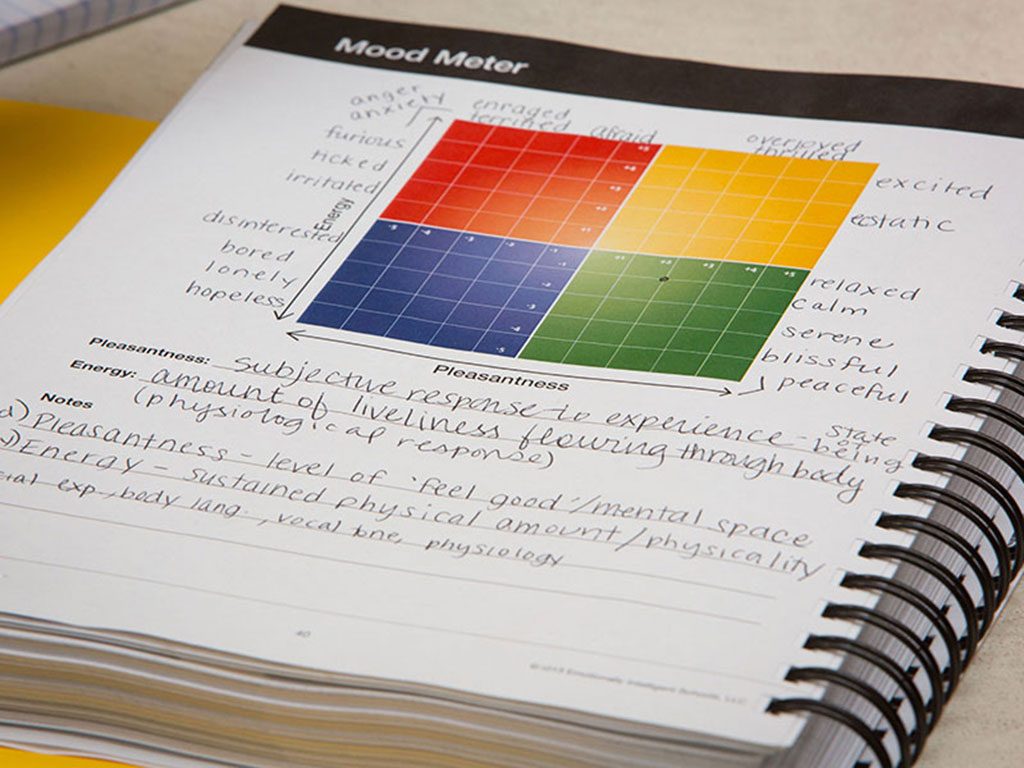Think about the last time someone made you angry while you were driving. How did you react? Did you honk at them? Yell out of your window? Throw up a few rude hand gestures?
We all experience moments when we react impulsively out of anger, fear, or other strong emotions. It rarely makes a bad situation better. But what steps can we take to turn those emotions into something productive?
For Marc Brackett, founding director of the Yale Center for Emotional Intelligence and author of the new book Dealing with Feeling: Use Your Emotions to Create the Life You Want, the answer is “emotion regulation.”
Brackett considers emotion regulation “the most important skill a human being can possess” (page 39). Being emotionally dysregulated doesn’t just lead to embarrassing episodes of lashing out — studies also show that the stress caused by unchecked emotions like anger, loneliness, and despair can increase the risk of heart disease and cardiovascular problems.
So we know emotion regulation is important. But what is emotion regulation? And how do we achieve it?
Contrary to popular belief, emotion regulation isn’t just the pursuit of happiness or positive emotion. For as long as folks have chased happiness, experts have warned us not to fetishize happiness at the expense of more holistic emotional well-being.
Emotion regulation isn’t about controlling or suppressing our feelings, nor is it about ignoring negative emotions in favor of the positive ones. Instead, it means “being conscious and intentional about your emotional life” (page 40). More specifically, emotion regulation is learning to harness the full spectrum of your emotions to create the life you want. Rather than suppressing or controlling certain feelings, you acknowledge and respond to all of them without judgment and then take steps to deal with them in a constructive way.
You likely already employ a few emotion regulation skills and techniques in your daily life. Every time you count to ten to calm your nerves or take a deep breath after getting cut off in traffic, you’re practicing a form of emotion regulation. The goal, however, is not just to practice emotion regulation in the heat of the moment but to integrate regulation strategies so fully into your life that they become second nature.
It isn’t easy, though! It takes practice to be mindful and guidance to get you there. Dealing with Feeling is a great resource for building such skills.
That’s why we’re sharing a few actionable tips from Dealing with Feeling on how to regulate emotions to help you start your journey. Remember that emotion regulation isn’t a “one size fits all” process. The more techniques you practice, the better off you’ll be when choosing how to respond to a given situation.
1. When you need to deescalate a negative emotion, remember PRIME:
Brackett often discusses the difference between “hot” and “cool” processing. While we usually need to face negative or distressing emotions head-on, there are times when the best course of action is to calm down so we don’t act irrationally or in self-destructive ways. For this, he uses PRIME, an acronym that teaches us how to cultivate a calmer, cooler emotional state:
Prevent unwanted emotions if we can.
Reduce them otherwise.
Initiate desirable emotions.
Maintain the feelings we want.
Enhance those whenever possible.
In Dealing with Feeling, Brackett cites the example of attending a holiday dinner with an aunt he finds frustrating. If you’re facing a similarly frustrating situation, you first need to decide what your goals are: Can you skip the event or do you have to go? What outcomes do you hope to achieve by attending? What can you do to reduce negative emotions in the situation and enhance positive feelings wherever possible?
2. Regulate positive emotions when necessary
Happiness and other cheerful feelings offer a significant boost to our confidence, yet they can also make us “disregard the details when making decisions” (page 54). It’s essential, therefore, to also regulate happiness and other positive emotions when necessary.
While it may sound a bit perplexing at first, this tip contains a great deal of wisdom. After all, anxiety has a protective function: It keeps us from making reckless decisions. Emotion regulation isn’t just about recognizing feelings, it’s also understanding how best to control our emotion responses to achieve a desired outcome. At times, an overwhelmingly positive feeling or emotion can have an unfavorable effect.
For instance, if you’re so excited about an upcoming trip that you can’t concentrate on your work in the days leading up to vacation, you may need to downregulate your giddiness to get a necessary task done. This approach works in the opposite direction as well. You might be dreading a task, so to get it done you need to ramp up excitement over the positive parts of the task or focus on the positive feeling of relief you’ll have when it’s over.
3. Take a deep breath
Breath work is a key emotional-regulation tool. Breathing slowly and deeply prevents you from acting on impulse, while activating your parasympathetic nervous system, which is responsible for promoting relaxation and calm. Brackett suggests exercises in Dealing with Feeling to help you improve deep-breathing skills so that you can draw on breath work when you need to regulate your emotions.
One simple technique Brackett highlights is called “box breathing” (page 133), which Navy SEALs use in high-pressure situations. In box breathing, you picture an object with four equal sides, like a box. Center your focus on the first side of the object, then follow this sequence: Breathe in for four seconds, hold for four seconds, exhale for four seconds, and then hold for four seconds. Afterward, move on to the next side of the imagined object to repeat the breathing sequence until all four sides are complete.
This deep-breathing technique is scientifically proven to foster a state of mental and physical calm and focus.
3. Practice mindfulness
Mindfulness is at the heart of emotion regulation. As Brackett points out, practicing formal and informal mindfulness helps you “start to discern your large emotional patterns” (page 139) in a way that makes regulating easier. You’ll also begin to notice and acknowledge your emotional triggers so that you can build strategies for dealing with them as they come.
Mindfulness is a state of mind that cultivates attention, acceptance, curiosity, and compassion. It traces back to Buddhist practices developed thousands of years ago, though similar mindfulness methods can be found in other religious traditions.
Brackett suggests not only working on individual mindfulness techniques but building mindfulness into your daily life. To improve your mindfulness, consider engaging in formal practices such as yoga or tai chi, or try informal practices like taking a moment to check in with your feelings to cultivate deeper awareness.
4. Disconnect from your devices
We know! This one is likely the hardest on the list. You’re reading this essay on a device right now.
Our phones and other electronic devices are designed to trigger powerful emotions and can often leave us feeling worse than before we picked them up. Do you feel better after doomscrolling before you go to sleep? Probably not. Do you feel more regulated after staring at social media or wading into a very hostile comments section? We doubt it.
One of the best things you can do to center yourself and become more mindful is to spend less time on your phone and more time being present in the world.
The good news? Just a little bit goes a long way. Try to avoid using your phone, tablet, or computer between dinner and bedtime. This helps clear your mind as you wind down for the night and builds healthy sleep patterns. It also encourages you to foster deeper connections with those around you.
5. Turn to the people who support you
One of Brackett’s most essential pieces of advice is to never worry alone.
Our emotions are influenced by those around us, and personal connection has a positive effect on our health and our ability to regulate emotions. Brackett points out that “when people feel connected, valued, and loved in their relationships, they are more likely to experience pleasant emotions, reduced stress, and increased self-esteem” (page 176). This, then, serves as a safeguard against the challenges we face emotionally.
The author urges everyone to find their support person or people where they can. A good support person is an attentive listener, nonjudgmental, and compassionate. They’re the person you can turn to talk through your emotions. It shouldn’t just be a solo endeavor!
If you lack someone who fits the bill right now, try expanding your social circle by joining local activities or getting involved with a local organization. You can also find a therapist to help you co-regulate your emotion reactions. Brackett suggests turning to a support person who isn’t physically there, whether it’s a faraway friend or even a deceased family member. Imagining their responses to your problems is far better than ruminating alone. If it helps, consider looking at a photo or video to induce their presence. Brackett notes that he’ll turn to pictures of supportive loved ones or his beloved pets to help guide him through moments of doubt or loneliness, and it works.
6. Lend someone else a helping hand
Seeking out someone else to help and guide is an excellent way to give back to those around you while also building your support network and strengthening your emotional-regulation abilities. So what practices can you cultivate to help friends and family in need?
Make sure to listen intently without distraction to demonstrate genuine interest in their problems. Avoid judgment or blame. Affirm their pain. Avoid turning the conversation back to your own issues. Don’t try to fix things, but instead ask questions that encourage growth or action from within: “Are there other ways to look at this situation?”
Brackett reminds us that while venting is cathartic and serves its purpose in emotional well-being, it ultimately won’t help change a challenging situation. After allowing someone to vent or venting yourself, try to move forward to solution-driven approaches and techniques that will ultimately bring you closer to a resolution.
7. Practice positive empathy and commit random acts of kindness
The power of the human bond is impossible to overstate. When you connect with someone else, you feel more grounded and often discover fresh perspectives on life. Connections also help you regulate your emotions.
Brackett points to several techniques that draw on the power of connection to help with emotion regulation. One such technique is celebrating the achievements of others through “positive empathy” (page 191). This goes beyond telling someone you know that they did a good job to truly engaging with their success: Ask them to explain how they achieved their victory, the emotions they felt, and what they learned from the experience. Expressing genuine appreciation like this will strengthen your bond with your friend and boost your spirits, knowing that you enriched their day.
Another option? Do something nice for someone else! Studies consistently show that initiating acts of kindness — whether with someone you know or a total stranger — will make you feel happier and more satisfied with your life. So the next time you’re feeling low, offer a bit of generosity to the person beside you. We assure you it will do wonders for your mood.
We hope that this essay offers a fresh perspective on the importance of emotion regulation and the path to greater emotional health. If you’re ever feeling overwhelmed, pick out a technique from this essay and implement it in your life. Then check out Marc Brackett’s Dealing with Feeling for an insightful and actionable guide to managing how we respond to our emotions to transform our lives.




